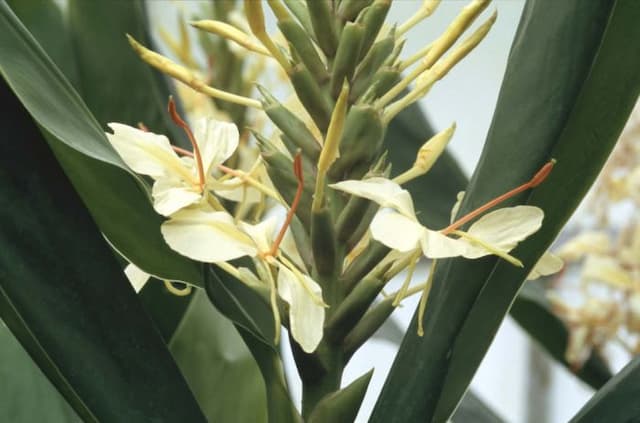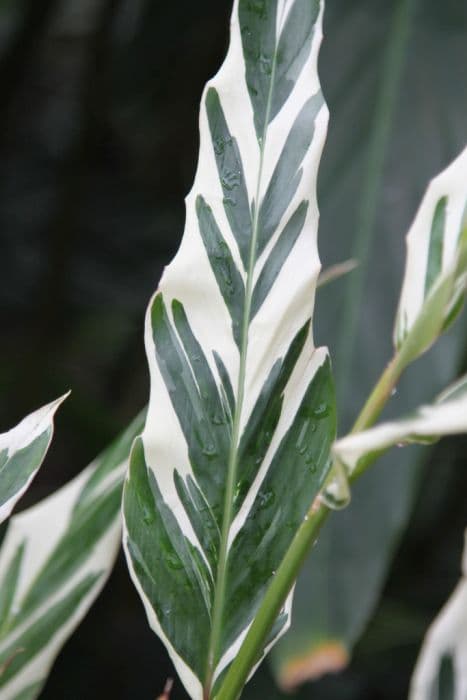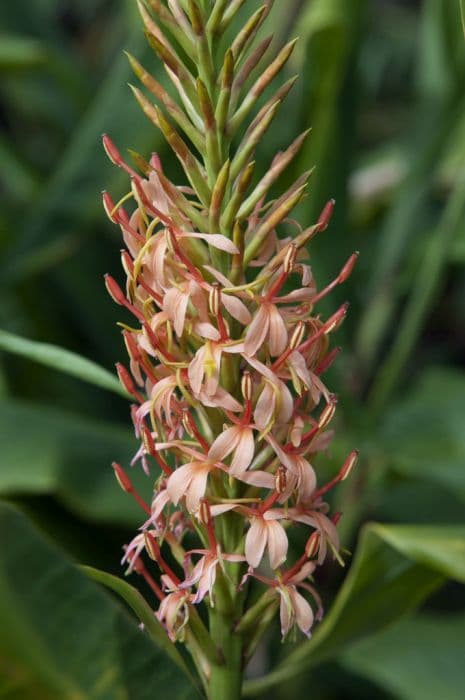Red ginger lily Hedychium greenii

ABOUT
Hedychium greenii, commonly known as Red Ginger Lily or Scarlet Ginger Lily, is an ornamental plant that carries a striking look. This species is primarily known for its vivid and attractive foliage which has a unique reddish hue. The leaves of the Red Ginger Lily are elongated with pointed tips and a glossy surface that captures the light, adding to its visual appeal. The undersides of the leaves typically exhibit a deeper red or maroon shade, contrasting sharply with the greenish topside. Red Ginger Lily flowers with flamboyant bloom spikes that have an exotic aesthetic. The flowers themselves are delicate, with a distinctive shape that is reminiscent of butterflies. They sport vibrant colors, often with petals of yellow and orange, accented by red or sometimes deep pink. These colorful blossoms cluster at the end of the stalks and can create a showy display that adds a tropical flair to any garden. The stems of the Red Ginger Lily are sturdy and upright, which complement the showy nature of the foliage and the flowers. Together, the combination of the intense foliage color and the bright flowers make the Red Ginger Lily a particularly eye-catching plant in any landscape where it appears. The overall impression of the plant is one of drama and tropical beauty, making it a favored choice for gardens that aim to create an impact with bold foliage and striking floral displays.
About this plant
 Names
NamesFamily
Zingiberaceae.
Synonyms
Green Ginger, Red Ginger Lily, Scarlet Ginger Flower.
Common names
Hedychium greenii.
 Toxicity
ToxicityTo humans
Red ginger (Hedychium greenii) is not commonly listed as a toxic plant to humans. However, it's always best to exercise caution and avoid ingesting plants that are not known to be safe or are not typically consumed as food. If a person were to ingest a significant amount of red ginger, they might experience gastrointestinal discomfort or irritation. But specific symptoms of poisoning from red ginger are not widely documented. It's important to contact a medical professional if ingestion occurs and any adverse reactions are noted.
To pets
Red ginger (Hedychium greenii) is also not widely known to be toxic to pets. However, similar to humans, the plant is not intended for consumption, and pets may experience gastrointestinal upset if they ingest parts of the plant. Common signs to watch for might include vomiting, diarrhea, or signs of oral irritation. It is always recommended to keep an eye on your pet and consult with a veterinarian if you suspect that they have consumed any part of the red ginger plant and are showing any concerning symptoms.
 Characteristics
CharacteristicsLife cycle
Perennials
Foliage type
Deciduous
Color of leaves
Green
Flower color
Red
Height
3-4 feet (0.9-1.2 meters)
Spread
2-3 feet (0.6-0.9 meters)
Plant type
Herb
Hardiness zones
8
Native area
Himalayas
Benefits
 General Benefits
General Benefits- Ornamental Appeal: Adds tropical flair to gardens with its striking red-orange flowers and reddish-green foliage.
- Attracts Pollinators: Flowers produce a sweet fragrance that attracts butterflies, hummingbirds, and beneficial insects.
- Easy to Grow: Robust and adaptable, Greenii is suitable for a variety of garden settings and requires minimal maintenance.
- Rapid Growth: Can quickly reach its full size, providing a lush look to garden spaces in a relatively short period.
- Tolerance of Conditions: Able to withstand a range of soil types and is moderately drought-tolerant once established.
 Medical Properties
Medical Properties- Antimicrobial activity: Hedychium greenii may possess compounds that have been shown to exhibit antimicrobial properties.
- Anti-inflammatory effects: Some studies suggest that extracts from the plant could have anti-inflammatory potential.
- Analgesic properties: There is a possibility that the plant contains substances that can relieve pain.
 Air-purifying Qualities
Air-purifying QualitiesThis plant is not specifically known for air purifying qualities.
 Other Uses
Other Uses- Hedychium greenii, commonly known as red ginger lily, can be used as a natural dye source, where its rhizomes might impart color to textiles or crafts.
- The flowers of the red ginger lily may be used in perfume production owing to their aromatic properties.
- Its tall and striking foliage can provide a visual barrier for privacy in gardens or around patios.
- The plant can be used in creating floral arrangements or as a source of cut flowers due to its attractive appearance.
- Beyond its ornamental value, red ginger lily can be included in sustainable landscaping as it attracts pollinators like butterflies and bees.
- In culinary practices, red ginger lily can be grown as an edible flower, although it should be used in moderation and with knowledge of any potential allergies or adverse reactions.
- Its essential oils may be extracted for use in aromatherapy or in the formulation of scented candles and room fresheners.
- Red ginger lily's rhizomes could potentially be used in natural water filtration systems to remove toxins, owing to the bioactive compounds present.
- As a companion plant, red ginger lily can help in repelling certain pests in an eco-friendly garden setting.
- The sap can sometimes be used as a mild adhesive in traditional or emergency situations when other adhesives are not available.
Interesting Facts
 Feng Shui
Feng ShuiThe Red Ginger Lily is not used in Feng Shui practice.
 Zodiac Sign Compitability
Zodiac Sign CompitabilityThe Red Ginger Lily is not used in astrology practice.
 Plant Symbolism
Plant Symbolism- Rarity: Hedychium greenii, commonly known as Red Ginger Lily, is not as commonly known or widespread as other ginger species, which can symbolize uniqueness or rarity.
- Exotic Beauty: With its striking red flowers and tropical origin, the Red Ginger Lily can symbolize exotic beauty, suggesting a connection to the unique and the strikingly beautiful.
- Attraction: The Red Ginger Lily's vivid flowers can also be said to symbolize attraction, drawing attention in a garden much as one might be drawn to an attractive person.
- Sensuality: The lush and vivid nature of the Red Ginger Lily can be seen as symbolizing sensuality and the pleasures of the senses.
- Diversity: As a member of the diverse ginger plant family, the Red Ginger Lily can symbolize the beauty and richness of diversity in nature.
 Water
WaterThe Red Ginger Lily should be watered thoroughly, allowing the soil to become moist but not waterlogged. During the growing season, water approximately once a week, using about 1 gallon for larger plants, adjusting for rainfall and temperature. It's important not to let the soil dry out completely, but also not to overwater, as standing water can lead to root rot. In winter, reduce watering frequency, providing enough to keep the soil slightly damp.
 Light
LightThe Red Ginger Lily thrives in bright, indirect sunlight. It should be placed in a location where it receives filtered light for most of the day, protected from the harsh afternoon sun which can scorch the foliage. The ideal spot enables it to be exposed to morning sun and afternoon shade or a spot with dappled light throughout the day.
 Temperature
TemperatureThe Red Ginger Lily prefers a warm climate with temperatures ranging between 60°F and 80°F. This plant can tolerate a minimum temperature of about 50°F, but ideal growth occurs within the warmer part of its range. Sudden drops below this minimum temperature or exposure to frost can be detrimental to the plant.
 Pruning
PruningPruning the Red Ginger Lily is necessary to remove dead or damaged foliage and to encourage bushier growth. Light pruning can be done throughout the growing season to maintain its shape. The best time for more extensive pruning is early spring before new growth begins. Pruning once a year is typically sufficient.
 Cleaning
CleaningAs needed
 Soil
SoilThe best soil mix for the Red Ginger Lily should be rich, well-draining, and slightly acidic to neutral, with a pH of 6.1 to 7.5. A mixture containing loamy soil, compost, and perlite or pine bark can work well to provide the necessary drainage and nutrients.
 Repotting
RepottingThe Red Ginger Lily should be repotted every 2 to 3 years or when the rhizomes have outgrown the pot. Spring is the best time to repot this plant to minimize stress and promote healthy growth.
 Humidity & Misting
Humidity & MistingRed Ginger Lily thrives in high humidity conditions. Ideally, maintain a humidity level of around 60% to ensure that the plant has enough moisture in the air for optimal growth.
 Suitable locations
Suitable locationsIndoor
Place Red Ginger Lily in bright, indirect light and keep soil moist.
Outdoor
Plant Red Ginger Lily in partial shade with moist, rich soil.
Hardiness zone
8-10 USDA
 Life cycle
Life cycleHedychium greenii, commonly known as Red Ginger Lily, begins its life cycle as a rhizome, which is an underground stem capable of producing the stem and root of a new plant. When conditions are favorable, typically in spring, the rhizome sends out shoots that grow into green stems and leaves. As the plant matures, it develops characteristic orange-red flowers with striking green foliage, usually in late summer or early fall. After the flowering period, the plant sets seeds that, when dispersed, can germinate to produce new plants. Throughout the growing season, the Red Ginger Lily stores nutrients in its rhizomes for the next cycle. In temperate regions, vegetation dies back in winter, while the rhizome goes dormant, surviving until conditions become suitable for the next growing season.
 Propogation
PropogationPropogation time
Spring to summer
The most popular method of propagation for Hedychium greenii, commonly known as Red Ginger Lily, is through division. This involves separating the rhizomes, which are the horizontal underground stems capable of producing the roots and shoots of a new plant. The best time to undertake this process is in the spring, just before the growing season begins. To propagate, dig up the rhizomes carefully to avoid damage, then cut them into sections ensuring each section has at least one growth bud. Plant these sections in well-draining soil, placing them around 2 to 3 inches deep (5 to 7.5 cm) and roughly 12 to 24 inches apart (30 to 60 cm). Water the newly planted rhizomes adequately to help establish the roots. Within a few weeks, growth should become apparent if the divisions were successful.









